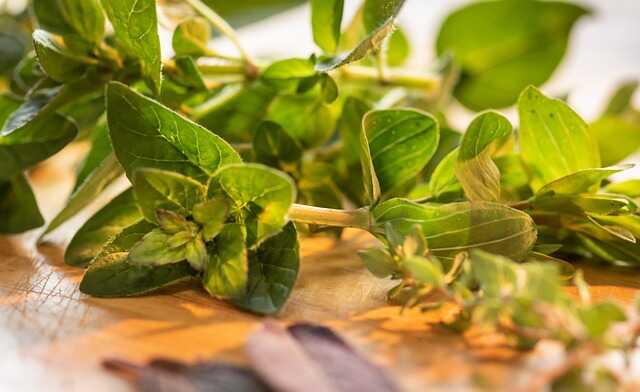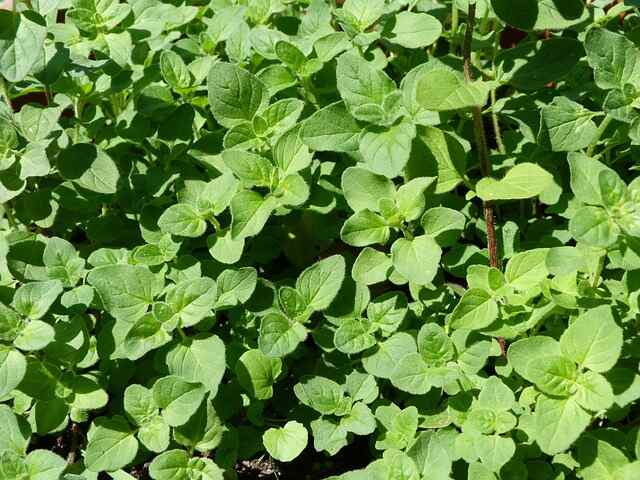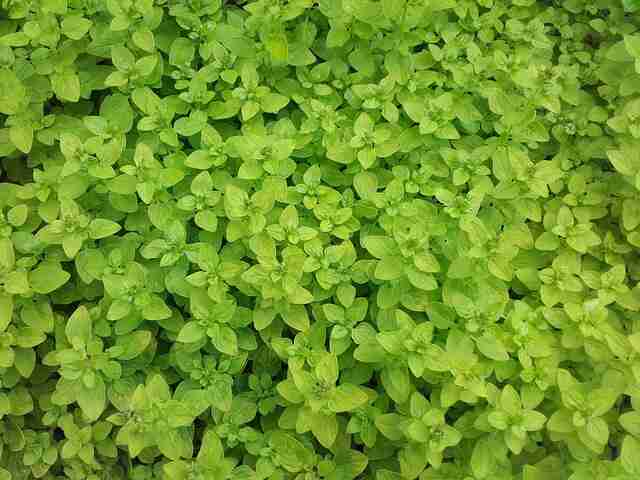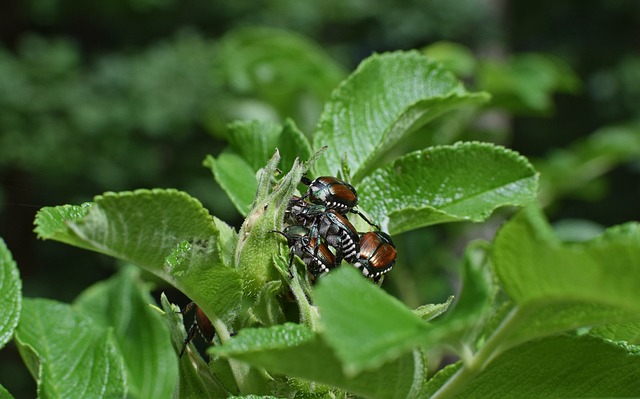If you’re looking for a versatile and flavorful herb to add to your garden, look no further than Marjoram! This aromatic herb is easy to grow and can be used in a variety of dishes, from soups and stews to sauces and marinades.
In this post, we’ll share our top tips for planting and growing marjoram in your herb garden. Whether you’re a seasoned gardener or a beginner, read this article to help you cultivate a healthy and productive marjoram plant.
Plant overview
Marjoram (Origanum majorana) is a perennial herb that is part of the mint family. It is native to the Mediterranean region and has been cultivated for thousands of years for its aromatic and culinary properties. It has a slightly sweet and floral flavor with hints of pine and citrus, making it a popular seasoning for many dishes.
Marjoram is a small, bushy plant that typically grows up to two feet tall. It has small, oval-shaped leaves that are a grayish-green color and produce small, white, or pink flowers in the summer months. It prefers well-drained soil and full sun, but can also tolerate partial shade. It is a hardy plant that can withstand dry periods but prefers regular watering.
It is commonly used in Mediterranean cuisine and is a staple herb in Italian, Greek, and French dishes. It pairs well with meats, vegetables, and sauces, and is often used in soups, stews, and marinades. In addition to its culinary uses, It also has medicinal properties and is used to treat a variety of ailments, including digestive issues and respiratory problems.
Overall, marjoram is an easy-to-grow and versatile herb that is a great addition to any herb garden. With its pleasant flavor and aromatic properties, it is a must-have herb for any home cook or gardener.
Benefits of growing marjoram in garden

Growing marjoram in your garden can offer many benefits, from enhancing your culinary creations to supporting your health and attracting beneficial insects. Its ease of growth and aromatic properties make it a great addition to any herb garden.
Growing it in your garden can offer several benefits, including:
Culinary uses
Marjoram is a popular herb in Mediterranean cuisine and can be used in a variety of dishes, such as soups, stews, sauces, and marinades. Growing your own herb can provide you with a fresh supply of this flavorful herb to enhance your culinary creations.
Aromatic properties
It has a pleasant and calming aroma, making it a great addition to your garden for its aromatic properties. The fragrance of marjoram can also help repel certain pests, making it a natural insect deterrent.
Medicinal properties
Marjoram has been used for centuries in traditional medicine to treat a variety of ailments, including digestive issues, respiratory problems, and headaches. Growing your own plant can provide you with a natural remedy to support your health and well-being.
Attracts beneficial insects
Marjoram is a great plant to attract beneficial insects, such as bees and butterflies, to your garden. These insects can help pollinate your other plants and improve your garden’s overall health.
Easy to grow
It is a hardy plant that is easy to grow and requires minimal maintenance. It is tolerant to dry conditions and can grow in a variety of soil types, making it a great herb for novice gardeners.
Companion planting
Marjoram is a great companion plant for other herbs and vegetables. It can help repel pests and improve the flavor of neighboring plants. It is particularly beneficial when grown alongside basil, thyme, and tomatoes.
Drying and storing
Marjoram can be easily dried and stored for later use. Simply harvest the leaves and dry them in a warm, dark place for several days. Once these plants are dry, it is suggested to store them in an airtight container in a cool, dry place. This will allow you to enjoy the flavor of this throughout the year.
Decorative purposes
Marjoram’s delicate leaves and flowers can add beauty and texture to your garden. It can be grown in a variety of garden styles, including herb gardens, container gardens, and raised beds.
Mental health benefit
Marjoram has been used for its soothing properties and may help reduce stress and anxiety. Growing and tending to your own plant can also provide a calming and meditative activity, promoting relaxation and well-being.
Cultural significance
It has been used for thousands of years in many cultures for its culinary, medicinal, and spiritual properties. It has been associated with love, happiness, and good fortune in some cultures, making it a meaningful and symbolic addition to your garden.
How to plant marjoram in your garden?
Sure, here are the steps for planting this in your garden:
Choose a sunny location
It thrives in full sun to partial shade, so choose a location that receives at least 6 hours of direct sunlight daily.
Prepare the soil
Marjoram grows best in well-drained soil with a pH between 6.5 and 7.5. Prepare the soil by removing any weeds, rocks, or debris, and amend it with compost or well-rotted manure to improve its fertility and texture.
Plant the seedlings
Marjoram can be started from seeds or transplanted as seedlings. If using seedlings, dig a hole slightly larger than the root ball and place the plant in the hole. Then backfill the hole with the prepared soil and gently firm the soil around the plant. Space your plants about 12 to 18 inches apart
.
Water the plants
Water the newly planted seedlings well, and continue to water them regularly to keep the soil evenly moist. Avoid overwatering, as Marjoram does not like to be in soggy soil.
Mulch the plants
Add a layer of organic mulch, such as straw or shredded leaves, around the base of the plants to help retain moisture, suppress weeds, and regulate soil temperature.
Prune the plants
Pinch back the tips of the plant regularly to encourage bushier growth and prevent it from getting leggy. You can also harvest the leaves regularly to use in your cooking or for drying and storing.
By following these simple steps, you can easily plant marjoram in your garden and enjoy its culinary and medicinal benefits.
How to care for marjoram in your garden?

Soil
Marjoram grows best in well-draining soil that is slightly alkaline with a pH between 6.5 and 7.5. It can tolerate a variety of soil types, but it prefers loamy soil that is rich in organic matter.
Before planting marjoram, it’s important to prepare the soil by removing any weeds, rocks, or debris and amending it with compost or well-rotted manure. This will improve the soil’s fertility and texture, providing the plant with the nutrients it needs to thrive.
Marjoram does not like to be in overly wet soil, so it’s important to ensure that the soil is well-draining. If your soil is heavy or poorly drained, you may need to amend it with sand or perlite to improve its drainage.
Overall, marjoram is a relatively easy plant to grow and will tolerate a range of soil types as long as the soil is well-draining and has a slightly alkaline pH.
Light
Marjoram is a sun-loving plant that requires at least 6 hours of direct sunlight per day to thrive. It can tolerate partial shade, but full sun is ideal for optimal growth and flavor development.
When selecting a planting location for marjoram, it’s important to choose an area that receives plenty of sunlight throughout the day. Avoid planting marjoram in areas that are shaded by trees, buildings, or other structures that may block the sun.
In addition to providing ample sunlight, it’s also important to ensure that the soil is well-draining and has a slightly alkaline pH between 6.5 and 7.5. By providing the right amount of sunlight and soil conditions, you can help your marjoram plants grow healthy and strong, producing flavorful leaves that can be used in a variety of culinary dishes.
Temperature
Marjoram is a warm-weather plant that grows best in temperatures between 60°F to 80°F (15.5°C to 27°C). It is a tender perennial herb that cannot tolerate freezing temperatures, and will not survive if exposed to frost.
If you live in an area with cold winters, it’s important to either grow marjoram as an annual plant or bring it indoors during the winter months. Marjoram can be grown indoors in a sunny window or under grow lights, as long as it receives the right amount of sunlight and moisture.
In warmer climates, marjoram can be grown as a perennial plant, coming back year after year. However, it’s important to ensure that the plant is protected from extreme heat and drought, which can cause it to wilt or even die. Providing regular water and shading the plant during the hottest parts of the day can help to keep it healthy and thriving in hot temperatures.
Overall, marjoram requires warm temperatures to grow and cannot tolerate freezing temperatures or extreme heat and drought. By providing the right growing conditions, you can help your marjoram plants thrive and produce flavorful leaves for use in your cooking.
Humidity
Marjoram does not have specific humidity requirements and can tolerate a range of humidity levels. However, it is important to avoid overwatering the plant, which can lead to excess moisture in the soil and increase humidity levels around the plant.
If you live in an area with high humidity, it’s important to ensure that the soil is well-draining to prevent water from accumulating around the plant’s roots. This can be achieved by adding sand, perlite, or other materials to the soil to improve its drainage.
In low-humidity areas, you may need to water your marjoram more frequently to prevent the soil from drying out completely. However, it is essential not to overwater your plant, as it may lead to root rot and other issues.
Overall, marjoram can tolerate a range of humidity levels and is more sensitive to overwatering than humidity levels. As long as you provide well-draining soil and avoid overwatering, your marjoram plants should thrive in a variety of humidity conditions.
Water
Marjoram requires moderate watering to grow and thrive. This plant prefers to grow in well-draining soil that is kept consistently moist, but not waterlogged. Overwatering can lead to root rot and other issues, so it’s important to avoid saturating the soil with water.
When watering marjoram, it’s important to water deeply to encourage the roots to grow deep into the soil. Allow the soil to dry slightly between watering to prevent overwatering, but don’t let the soil dry out completely. During hot weather or drought conditions, you may need to water your marjoram more frequently to prevent the soil from drying out.
It’s also important to water the plant at the base rather than from above, as wetting the leaves can increase the risk of fungal diseases. Use a watering can or drip irrigation system to water the plant at the base, avoiding the leaves and stems.
Overall, marjoram requires moderate watering to grow and thrive, with well-draining soil that is kept consistently moist but not waterlogged. By providing the right amount of water, you can help your marjoram plants grow healthy and strong, producing flavorful leaves for use in your cooking.
Fertilizer
When planting marjoram, you can mix a slow-release fertilizer into the soil to provide nutrients over time. Alternatively, you can apply a balanced, all-purpose fertilizer every 4-6 weeks during the growing season. Avoid applying too much fertilizer, as this can lead to excessive growth and reduce the flavor and aroma of the leaves.
You can also use organic fertilizers, such as compost or worm castings, to provide nutrients to the soil. These organic fertilizers are slow-release and can help to improve the soil’s structure and fertility over time.
It is very essential to follow the instructions of the manufacturer when applying fertilizer and to avoid over-fertilizing the plant. Too much fertilizer can cause the plant to become overly lush and reduce the intensity of the flavor and aroma of the leaves.
Overall, marjoram can grow well with moderate soil fertility, but adding some fertilizer can help to promote healthy growth and improve the flavor and aroma of the leaves. By providing the right amount of fertilizer, you can help your marjoram plants grow healthy and strong, producing flavorful leaves for use in your cooking.
How to harvest marjoram?

Harvesting marjoram is a simple process that involves picking the leaves as needed throughout the growing season. To ensure the best flavor and aroma, it’s best to harvest marjoram in the morning after the dew has dried but before the sun gets too hot.
To harvest marjoram, simply use scissors or pruning shears to snip off the stems just above a leaf node, taking care not to damage the rest of the plant. Avoid harvesting more than one-third of the plant at a time, as this can weaken the plant and reduce its ability to produce new growth.
It’s important to harvest marjoram regularly throughout the growing season to encourage the plant to produce new growth and prevent it from becoming too leggy. If you have more marjoram than you can use fresh, you can dry the leaves for later use.
To dry marjoram, simply tie a bunch of stems together with twine and hang them upside down in a cool, dry place. Once the leaves are completely dry, you can remove them from the stems and store them in an airtight container for later use.
Overall, harvesting marjoram is a simple process that involves picking the leaves as needed throughout the growing season. By harvesting regularly and drying the leaves for later use, you can ensure a steady supply of flavorful marjoram for your culinary creations.
How do prune marjoram in your garden?
Pruning marjoram is an important part of maintaining the health and productivity of the plant. Regular pruning can help to encourage new growth and prevent the plant from becoming too leggy.
To prune marjoram, use a pair of clean, sharp scissors or pruning shears to snip off the top one-third of the plant. This will encourage new growth and help to prevent the plant from becoming too tall and spindly.
You can also prune individual stems as needed to remove any dead or damaged growth. Simply snip off the stem just above a leaf node, taking care not to damage the rest of the plant.
It’s important to avoid pruning too much of the plant at one time, as this can weaken the plant and reduce its ability to produce new growth. Instead, prune regularly throughout the growing season, taking care to remove no more than one-third of the plant at a time.
Overall, pruning marjoram is a simple process that involves removing the top one-third of the plant to encourage new growth and prevent the plant from becoming too leggy. By pruning regularly, you can help your marjoram plants stay healthy and productive, producing flavorful leaves for use in your cooking.
Common Pests and Diseases

Marjoram is generally a hardy plant that is not prone to many pests and diseases. However, there are a few common issues that can affect marjoram plants:
Powdery mildew
Powdery mildew is a fungal disease that appears as a white, powdery coating on the leaves of the plant. It can be prevented by ensuring good air circulation around the plant and avoiding overhead watering. If powdery mildew appears, you can treat it with a fungicide.
Aphids
Aphids are tiny insects that can cause damage to the leaves and stems of the plant. They can be controlled with insecticidal soap or by spraying the plant with a strong jet of water to knock them off.
Spider mites
These tiny pests can cause damage to the leaves of the plant, leaving behind a fine webbing. They can be controlled with insecticidal soap or by spraying the plant with a strong jet of water to knock them off.
Root rot
Root rot is a major fungal disease that can be caused by overwatering or poor drainage. To prevent your plant from root rot, make sure that the soil is well-draining and allow the top inch of soil to dry out between waterings.
Fusarium wilt
This fungal disease can cause wilting and yellowing of the leaves. It can be prevented by ensuring good air circulation around the plant and avoiding overwatering.
Overall, marjoram is a relatively easy plant to grow and is not prone to many pests and diseases. By providing the plant with the proper growing conditions and monitoring for any signs of problems, you can help to ensure a healthy and productive marjoram plant.
Conclusion
Marjoram is a wonderful addition to any herb garden, providing both culinary and medicinal benefits. With its delightful aroma, delicate leaves, and ease of growth, marjoram is a versatile herb that can be used in a variety of dishes, from soups and stews to sauces and marinades.
To ensure a healthy and productive marjoram plant, it’s important to provide it with the proper growing conditions, including well-draining soil, adequate light and moisture, and proper spacing. Regular pruning and monitoring for any signs of pests or diseases can also help to keep your marjoram plant thriving.
Whether you’re an experienced gardener or just starting out, growing marjoram in your herb garden is a great way to add flavor and fragrance to your cooking, as well as provide potential health benefits. So why not give Marjoram a try and enjoy all the benefits it has to offer?
You may also like to read







